Most free-to-play games on mobile sell some sort of premium currency: gems in Clash of Clans, donuts in Simpsons Tapped Out, gold in Game of War and so on. I spent some time analysing how 32 games on the App Store sell their premium currency, and some interesting trends and tricks emerged.
The Games
Before we proceed, meet my data set. The 32 games analyzed are:
8 Ball Pool, Angry Birds Go!, Boom Beach, CastleVille Legends, Clash of Clans, Clumsy Ninja, CSR Racing, Disco Zoo, Dungeon Keeper, Empire, Farm Heroes Saga, Game of War, Hay Day, Hobbit: KoM, Jelly Splash, Juice Cubes, Kingdoms at War, Kingdoms of Camelot, Knights & Dragons, Modern War, Monster World, Moshi Monsters Village, Papa Pear Saga, Pocket Village, Puzzle & Dragons, Real Racing, Royal Revolt 2, Samurai Siege, Simpsons Tapped Out, Smurf's Village, Subway Surfers, Top Eleven.
My method for selecting games was pretty unscientific... just a mix of games I had played, wanted to play, or were in the AppStore top grossing. Perhaps I'll expand on the list some day.
Trends & Tricks
1) There is not much variety in pricing

A lot of games offer the same 5 price points: ?2.99, ?6.99, ?13.99, ?34.99, ?69.99. Those are the 5 big bubbles you see in the diagram above. (That's $4.99, $9.99, $19.99, $49.99, $99.99 for American readers). The most popular thing to do is to offer those 5 price points exactly with no changes, as is done in Supercell's Boom Beach for example.

This exact price progression accounts for 1/5th of all games surveyed. If you also count price progressions that are within 1 price of the most popular (meaning they can be reached by either adding, modifying or subtracting just 1 price from the progression), you've got over 3/5ths covered. Extend it again to count price progressions within 2 prices and almost all games are accounted for.
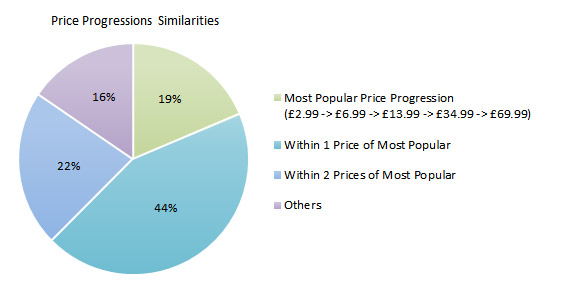
Very few games deviate from this formula... Moshi Monsters Village and Empire are tied for the most unique price points award, with each offering 4 unique prices that no other game does. It's nice to see someone trying something a little different, it will be interesting to see if their pricing catches on.
2) Players agree on a minimum price, publishers don't
The only price that games seem to disagree on is the minimum to charge.
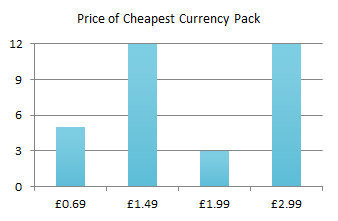
I wanted to know: is it worth offering a minimum price cheaper than ?2.99? The App Store most popular purchase ranking reveals some interesting information.
- In 100% of cases where ?2.99 is the cheapest price, it is also the most popular purchase.
- 17 games had both a starting price cheaper than ?2.99, as well as a price point at ?2.99.
- For the majority (70%) of those 17 games, ?2.99 was still the most popular price point.
The same information visualized:
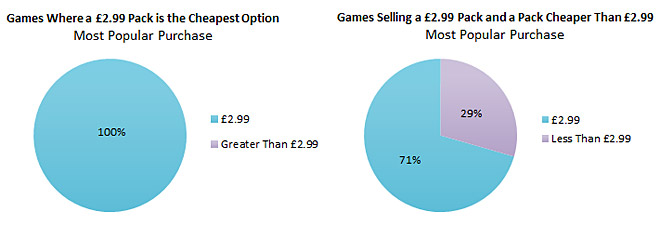
It appears that even if you offer players a minimum price point cheaper than ?2.99, chances are they will probably still prefer to buy the ?2.99 option. But some questions remain...
a) When ?2.99 is the cheapest option, how many sales are lost from players only willing to pay less than ?2.99?
b) And how much revenue is gained from players that would have preferred a cheaper option but paid ?2.99 anyways because there was no cheaper option?
c) And most importantly, which is greater? A or B?
Unfortunately I don't have enough data to answer it. But it did make me think back to a talk I watched long ago in which a publisher claimed "you'd be surprised how many people who are willing to pay a dollar for something, will also be willing to pay 5 dollars". He goes on to express regret for setting the price too low. If it was up to me, I would probably start pricing at ?2.99 and then lower the price later through special starter pack offers if need be. It's always easier to lower a price than it is to raise it!
3) Buying more is not always a better deal for the player
I assumed that by buying a larger currency pack, I would always get more currency per dollar spent. This is not always the case. The most significant example of this I came across was in Angry Birds Go:

Pay 2.5 times as much, but only get 2.1 times as many gems. If you want 2,500 gems, you can save money by buying 2 x 1,200 gems + 1 x 100 gems for a total cost of ?29.97 - a whole ?5 cheaper than the 2,500 gems priced at ?34.99. Those are savings you could use to buy another 300 gems. It's hardly an isolated incident. 70% of the games surveyed do this kind of thing. Sometimes, you see the same thing happening in the US store.
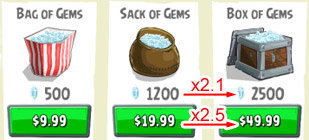
Other times I think it has to do with price localization. When something is priced at $4.99 in the US it is typically sold for ?2.99 in the UK. But for some reason $9.99 (double 4.99) becomes ?6.99 (more than double ?2.99) whereas it really should be ?5.99. Take Hay Day for example.

Not sure how or why this practice originated, but I didn't see any games adjust the premium currency given as a result so sometimes we end up getting less currency per ?1 than you would get per $1. 4) 'Most popular' doesn't have to mean most popular As a player, don't trust everything publishers tell you. In only 1 out of 8 games that prominently displayed a "Most Popular" badge next to a currency pack, was that also the actual most popular purchase in the App Store ranking. Angry Birds Go, the only one to correctly label the "Most Popular" offer:
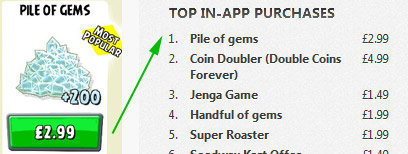
Does this mean everybody else is lying? I guess if at some point in the past or in a different territory the offer tagged as "Most Popular" was actually most popular, then you could say it's just out of date. In any case, it wouldn't be in any publisher's best interest because in all 7 cases where the "Most Popular" was mislabeled, a cheaper offer was the most popular and who would want to encourage players to buy a cheaper pack? Apparently only Rovio is honest enough. 5) There's more than 1 way to calculate a bonus A few games like to tell players exactly how much of a better deal the larger currency packs are. There are different ways of calculating this which can make the discount sound more or less impressive.
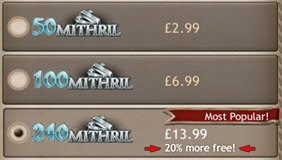
This first example is from Kabam's Hobbit game.
The lowest amount of gems per ?1 is found in the ?6.99 pack: 100 / 6.99 = 14.3 currency per ?1. At this exchange rate, for ?13.99 you should get 13.99 x 14.3 = 200 currency. But they give you 240 for ?13.99 instead of 200. 240 / 200 = 1.2, thus you are getting 120%, ie 20% more than you should get.
The numbers have been arranged so as to maximize how impressive the bonus sounds while remaining 100% truthful. Not everybody calculates it the same way. Here's a different example from flare's Royal Revolt 2.
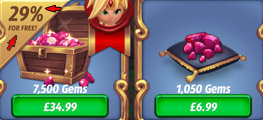
Like Hobbit, they use the lowest exchange rate which again is from the ?6.99 pack. At that rate, you should get 5,256 currency for ?34.99 but instead they give you 7,500. This is where the method diverges from Hobbit. The extra amount of currency being given is 7,500 - 5,256 = 2,244. 2,244 / 7,500 = 0.299, so we can say that of the 7,500 currency you are being given 29% for free.
First off, they could easily have rounded 29.9% up to 30%. More significantly, using Hobbit's method you could say that 7,500 / 5,256 = 1.43, therefore it is equally honest to say that you are getting 43% extra. Another interesting example is Monster World.
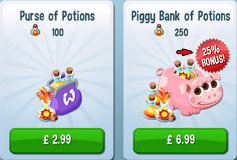
If you try to calculate the bonus using any sane method, it just doesn't make sense. It had me stumped for a little while. Then I checked the US AppStore pricing and it all fell into place.

If you use the US prices, the bonuses make perfect sense using the same method as Hobbit. So it appears that when the prices were localized, the bonuses were not. In reality, the bonuses in the UK AppStore are far less generous than their US counterparts (eg 7% UK instead of 25% US for 100 potions and 70% UK instead of 100% US for 4,000 potions).
Final Words
I hope this information helps anyone working on (or simply curious about) f2p game premium currency pricing. There's certainly a lot more going on with the prices than is obvious at first glance. The more I looked, the more I found. Still not satisfied? Try my spreadsheet. It's full of extra figures and graphs I didn't consider important enough to single out. And if you find something in the data I missed, let us know!
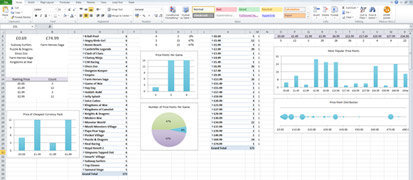
Note: This post was originally published on Wolfgang's blog AllWorkAllPlay, and is republished with Wolfgang's kind permission.

Interesting article. As a gamer I can't stand this model though and I stay away from these games. As a developer I like the ways this can provide a way to make money. I think how you make the game interact with in-game purchases is a balance that is hard to make work as to not make it basically required and making customers upset that you pay to win.